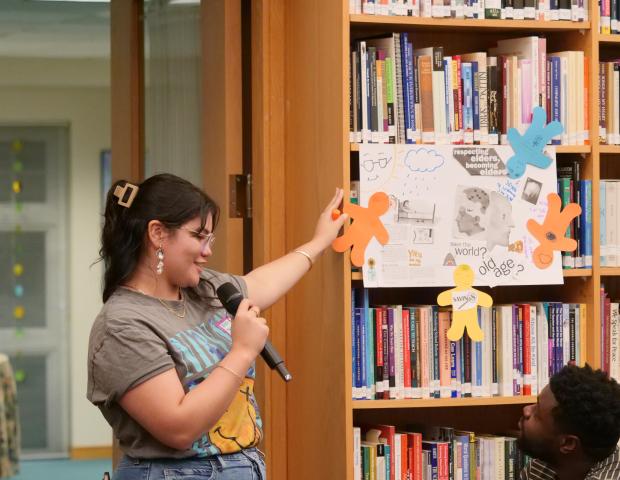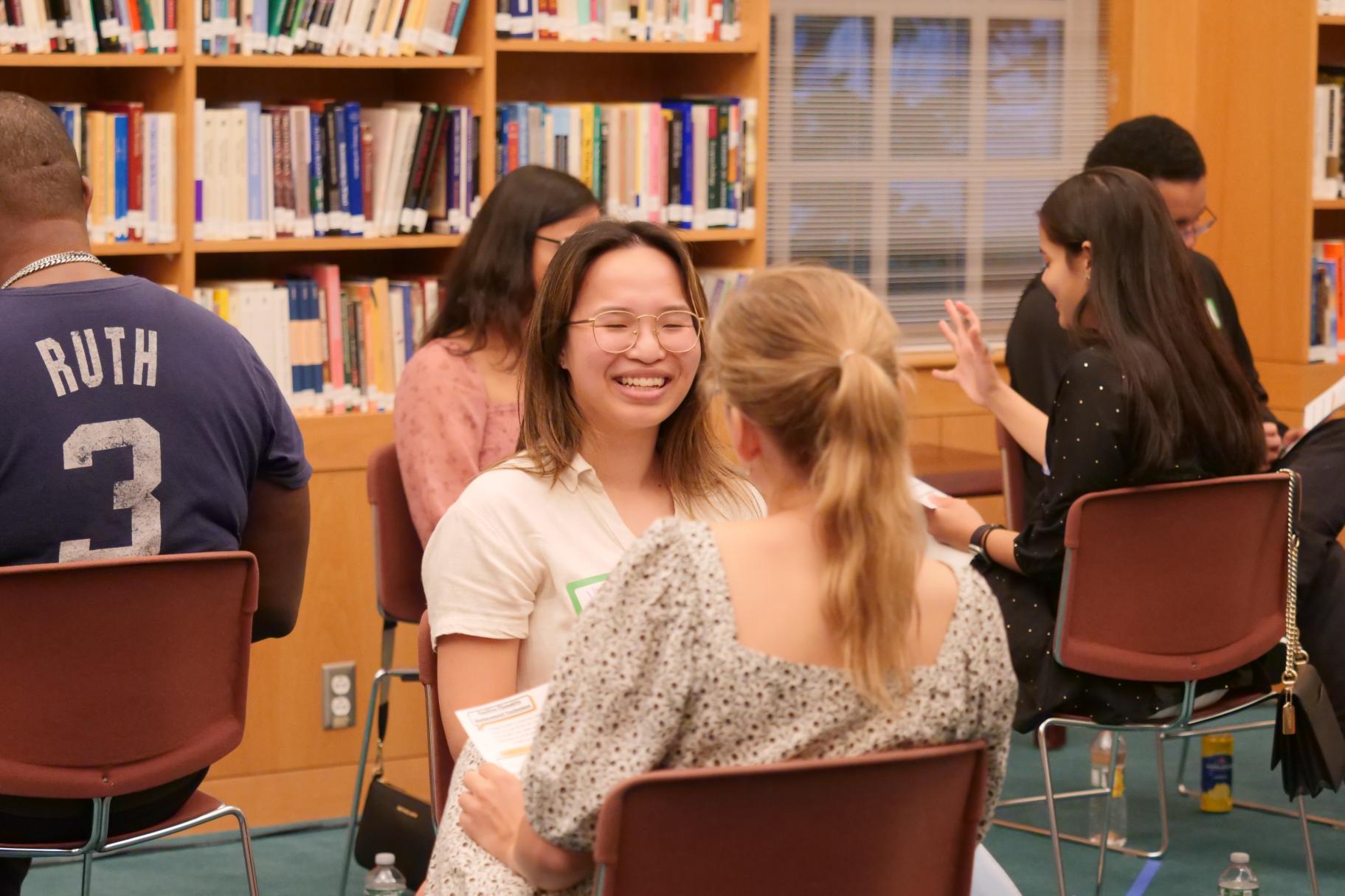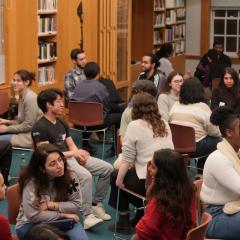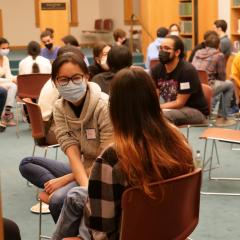Dialogue Nights, #32: Are We Living In An Era of Anxiety? Let’s Talk About It
A participant at Dialogue Nights shares about their group's collage
This Dialogue Nights might be about anxiety, said event moderator Preandra Noel, but the energy that’s “already prevalent in this room” is certainly “opposite to that.” As the high-spirited crowd of more than 50 attendees gathered for this August 2024 event, Preandra explained that the mission of the Ikeda Center is to build cultures of peace through learning and dialogue informed by Buddhist humanism, especially as presented by “our late founder, Daisaku Ikeda.”
Key to building such cultures of peace is to create conditions for people to relate to one another on the basis of their true self. In that spirit, Preandra said that “before we dive into an ocean of dialogue, I’d like to invite everyone” to engage in a “quick grounding activity.” With hands on their chests, and after deeply inhaling and exhaling, attendees spoke the affirmation: “I give myself permission to show up as my whole self. My contributions to this space are extremely valuable.” Then, after another inhalation and exhalation, each person thanked the person sitting across from them for showing up.
In a recently-incorporated Dialogue Nights tradition, participants engaged in some “speed connecting” before moving on to the main dialogue session. The way this activity works is that participants pair up for quick, 10 minute dialogues that bring aspects of each person’s personality and values to the fore. This evening, participants dialogued on two questions, finding different partners for each: 1) Reflecting on your childhood, what did you enjoy doing as a kid? What did playtime look like for you? 2) What are some open questions in your life right now? How are they making you feel? After speed connecting, participants viewed a brief video that introduced some current thinking on anxiety both as a social and a bio-physical problem or challenge. Then, to wrap up the opening round of activities, Preandra led everyone in a quick anxiety audit, first asking participants how they would rate their daily anxiety on a scale of 1 to 5. She then asked them to identify where in their bodies they usually manifest that anxiety. Audit complete, Preandra said, “I hope you’re ready to embrace a little goofiness with me” by getting up and just doing some free bodily movement. “Just shake off your anxiety wherever it’s at.”
Inner Resolve and the Replacing of Negative Thoughts
The main dialogue activity of the evening was led by the Center’s summer ‘24 program intern, Lanre Adeyanju. Taking the mic, she said, “I was shaking off my anxiety back there to get ready to come up here!” And, hopefully “you’ve all had the opportunity to shake off some tension with your movements,” adding that she appreciated that everyone engaged in “that reflective moment to just listen to your senses and identify different parts of your body where you may be feeling anxious or tense.” When thinking about how we deal with anxiety, said Lanre, it is worth recalling Center founder Daisaku Ikeda’s faith in “the power of a strong inner resolve in guiding even the most difficult life situation and predicament.” Ikeda tells us:
Through the power of strong inner resolve, we can transform ourselves, those around us and the land where we live. Each of you has this tool, this ‘secret weapon.’ There is no greater treasure … . Everything depends on our attitude or inner resolve, on the kind of philosophy and convictions that we cherish. Our environment or circumstances are not the determining factors. When we advance resolutely based on this … then all the hardships we experience will pave the golden path of our mission.
Inviting everyone to keep this quote in mind, Lanre introduced the next activity, which, she said, would center on a “thought replacement technique.” With the goal of developing what Lanre called our “constant state of mind,” each person received a worksheet with two columns. In the first column, the participant was invited to write down any “negative automatic thoughts you typically have when you are anxious or nervous.” An example would be: I’m going to be a failure if I don’t get this new job/opportunity I’m looking for. After writing down their thoughts, participants paired up for dialogue on similarities and differences in their responses. Following that, each person was invited to write in the other column a positive thought to replace each negative one. For the job example, a positive replacement might be: I don’t know for certain the outcomes of my job application, and It’s okay if I don’t get the job, I will continue to look for more opportunities.
After dialogue on the positive replacement thoughts, everyone gathered for a share-back session. Many interesting and inspirational ideas were offered, including these:
- Replacing the negative framing of “What if” this or that happens with “Even if” that happens it’ll be okay.
- Replacing thoughts that “I’m awkward and people don’t connect with me” with a reminder not to “read into people’s expressions” too much; they could be “thinking about anything.”
- Replacing worried thoughts about “sitting in a room where my confidence is not high” with “knowing that I’m here for a reason.”
Wrapping up, Lanre said “Thank you all so much for that!” It’s an activity that “can be scary at first,” but “you guys explored it” well, as we heard during the “beautiful” shareback. With that, she turned the floor back over to Preandra for the evening’s concluding activity.
Illustrating Our Anxiety and Responses To It
Thanking Lanre for leading that activity, Preandra asked for a round of applause for her, as it was actually the last day of her internship. “Hopefully,” she continued, that last activity “helped you see the value in your anxiety, especially if you have a negative relationship to it.” Moving on to the final activity, Preandra explained that everyone would gather into groups of four to make anxiety collages, thus engaging their nonverbal capacities. Telling participants they would draw from a “collage kit” of various materials and sources, she encouraged them: “Don’t overthink it. Follow your heart. You know, you might draw squiggly lines, stick on a bunch of stickers, write words, cut things out of the magazine that’s also provided.” Go ahead and “make a beautiful mess” with your feelings, said Preandra. One element to be included in every collage, she added, would be a human figure with a symbol placed in the spot where “anxiety resides or is present in your body.”
After completing their collages, some of the groups shared thoughts on their visual choices, and all of the collages were posted around the room. Many included inspirational phrases such as “Now I become myself” and “Forgiveness as power” and “There’s still time.” In the spaces of stress in the body, many used symbols of flowers or stars. Others worked with images of music as a source of escape and calm. One group used a cactus to represent “thriving and resiliency in the face of anxiety.” Another person split their figure in half with rain on one side and sun on the other. This is because “somebody’s rain is somebody’s sun,” they said, “and somebody’s sun is somebody’s rain. So it’s a case of what is your saving grace.” One collage featured a bar graph rising along the axis of “integrity and loving myself.” And striking a lighter note, one group found a portrait of “someone who looks like Dumbledore. So we thought of Harry Potter [and how] it’s not tragic, but magic.”




